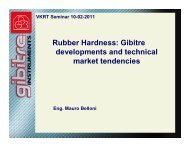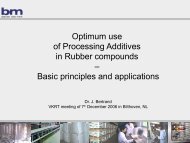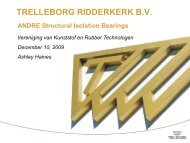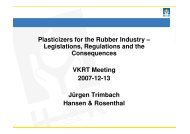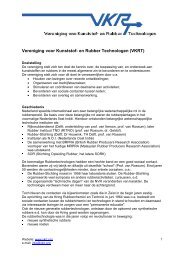Measuring the Payne effect in filled rubber - VKRT
Measuring the Payne effect in filled rubber - VKRT
Measuring the Payne effect in filled rubber - VKRT
Create successful ePaper yourself
Turn your PDF publications into a flip-book with our unique Google optimized e-Paper software.
<strong>Measur<strong>in</strong>g</strong> <strong>the</strong> <strong>Payne</strong> <strong>effect</strong> <strong>in</strong><strong>filled</strong> <strong>rubber</strong><strong>VKRT</strong> meet<strong>in</strong>g, May 14, 2009ELASTOMER RESEARCH TESTING B.V.<strong>VKRT</strong> 1
ELASTOMER RESEARCH TESTING B.V.As is <strong>in</strong> <strong>the</strong> name: ERT B.V. provides research andtest<strong>in</strong>g facilities <strong>in</strong> <strong>the</strong> <strong>rubber</strong> field for third parties.One of <strong>the</strong> properties of <strong>filled</strong> <strong>rubber</strong> we are work<strong>in</strong>gon is <strong>the</strong> measurement of <strong>the</strong> <strong>Payne</strong> <strong>effect</strong>.The <strong>Payne</strong> <strong>effect</strong> is directly related to <strong>the</strong> dynamicproperties of <strong>the</strong> vulcanized <strong>rubber</strong>.ELASTOMER RESEARCH TESTING B.V.<strong>VKRT</strong> 2
The <strong>Payne</strong> <strong>effect</strong> <strong>in</strong> <strong>filled</strong> <strong>rubber</strong> is <strong>the</strong>phenomenon of a stra<strong>in</strong> dependent dynamicmodulus.In carbon black or silica <strong>filled</strong> <strong>rubber</strong> we measure ahigh dynamic modulus at low stra<strong>in</strong>s (< 1%) whichdecreases at higher stra<strong>in</strong>s (> 10%).The reason for this phenomenon is <strong>the</strong> formation of anetwork formed by filler-filler <strong>in</strong>teraction.For carbon black <strong>the</strong> <strong>in</strong>teractions are Van der Waalsforces and for silica <strong>the</strong> much stronger hydrogenbond<strong>in</strong>gs.ELASTOMER RESEARCH TESTING B.V.<strong>VKRT</strong> 3
André Wehmeier, <strong>VKRT</strong> February 14, 2008.ELASTOMER RESEARCH TESTING B.V.<strong>VKRT</strong> 4
Possible mechanisms for <strong>the</strong> <strong>Payne</strong> <strong>effect</strong>.(i)(ii)(iii)(iv)<strong>the</strong> destruction-reformation of a filler networkadsorption-desorption of polymeric cha<strong>in</strong>s at<strong>the</strong> filler <strong>in</strong>terfacedisentanglement of bulk polymer from <strong>the</strong><strong>rubber</strong> bounded to <strong>the</strong> surfacestra<strong>in</strong>-soften<strong>in</strong>g of <strong>the</strong> glassy polymer shellsurround<strong>in</strong>g <strong>the</strong> particles surfacesIn real life this means an energy loss and <strong>the</strong> <strong>in</strong>tentionis to m<strong>in</strong>imize this <strong>effect</strong> <strong>in</strong> <strong>filled</strong> <strong>rubber</strong> (but with <strong>the</strong>re<strong>in</strong>forcement reta<strong>in</strong>ed).ELASTOMER RESEARCH TESTING B.V.<strong>VKRT</strong> 5
How to measure this filler-filler <strong>in</strong>teraction.The first remark about this phenomenon was <strong>in</strong> 1942by Gehman.The Dutch “Rubber Sticht<strong>in</strong>g” played a pronounced roll<strong>in</strong> <strong>the</strong> discovery of this phenomenon.In 1954 S. de Meij and G.J. van Amerongen presented<strong>the</strong>ir results on <strong>the</strong> ‘DKG Tagung’ <strong>in</strong> Munich.Part of <strong>the</strong>se results were published <strong>in</strong> 1956.ELASTOMER RESEARCH TESTING B.V.<strong>VKRT</strong> 6
<strong>Measur<strong>in</strong>g</strong> device of Seel de Meij.ELASTOMER RESEARCH TESTING B.V.<strong>VKRT</strong> 7
KAUTSCHUK UND GUMMI, 9. Jahrgang, Nr. 3/1956ELASTOMER RESEARCH TESTING B.V.<strong>VKRT</strong> 8
L. Guy, IRC Lyon, 2006samples were tested <strong>in</strong> pure shear with a Metravib VA3000 analyzerELASTOMER RESEARCH TESTING B.V.<strong>VKRT</strong> 10
L. Guy, IRC Lyon, 2006ELASTOMER RESEARCH TESTING B.V.<strong>VKRT</strong> 11
<strong>Measur<strong>in</strong>g</strong> <strong>the</strong> <strong>Payne</strong> <strong>effect</strong>.The <strong>Payne</strong> <strong>effect</strong> is difficult to measure <strong>in</strong> tension(s<strong>in</strong>gle stra<strong>in</strong>) and measur<strong>in</strong>g <strong>in</strong> compression meansthat <strong>the</strong> test piece has to be glued as is done <strong>in</strong> <strong>the</strong>Metravib VA3000 analyzer.The o<strong>the</strong>r modes are shear and torsion; ERT has<strong>the</strong> option make use of an Eplexor and a RPA.ELASTOMER RESEARCH TESTING B.V.<strong>VKRT</strong> 12
Measurements <strong>in</strong> shear on <strong>the</strong> Eplexor.ELASTOMER RESEARCH TESTING B.V.<strong>VKRT</strong> 14
RPA <strong>Payne</strong> <strong>effect</strong> (G') of vulcanized samples2,01,5G' (MPa)1,0207-03207-040,50,00,1 1 10 100stra<strong>in</strong> (%)ELASTOMER RESEARCH TESTING B.V.<strong>VKRT</strong> 15
Eplexor G' of vulcanized samples2,01,5G' (MPa)1,0207-03207-040,50,00,1 1 10 100stra<strong>in</strong> (%)ELASTOMER RESEARCH TESTING B.V.<strong>VKRT</strong> 16
Comparison <strong>Payne</strong> <strong>effect</strong> (G') measurements2,0G' (MPa)1,51,00,5RPA-03RPA-04Eplexor-03Eplexor-040,00,1 1 10 100stra<strong>in</strong> (%)ELASTOMER RESEARCH TESTING B.V.<strong>VKRT</strong> 17
RPA G" of vulcanized samples0,200,15G" (MPa)0,10207-03207-040,050,000,1 1 10 100stra<strong>in</strong> (%)ELASTOMER RESEARCH TESTING B.V.<strong>VKRT</strong> 18
Eplexor G" vulcanized samples0,100,08G" (MPa)0,060,04207-03207-040,020,000,1 1,0 10,0 100,0stra<strong>in</strong> (%)ELASTOMER RESEARCH TESTING B.V.<strong>VKRT</strong> 19
Comparison of G" vs. stra<strong>in</strong>0,20G" (MPa)0,150,100,05RPA-03RPA-04Eplexor-03Eplexor-040,000,1 1 10 100stra<strong>in</strong> (%)ELASTOMER RESEARCH TESTING B.V.<strong>VKRT</strong> 20
RPA tan δ of vulcanized samples0,300,25tan δ0,200,150,10207-03207-040,050,000,1 1 10 100stra<strong>in</strong> (%)ELASTOMER RESEARCH TESTING B.V.<strong>VKRT</strong> 21
Eplexor tan δ vulcanized samples0.3tan δ0.20.1207-03207-040.00.1 1.0 10.0 100.0stra<strong>in</strong> (%)ELASTOMER RESEARCH TESTING B.V.<strong>VKRT</strong> 22
Comparison of tan δ vs. stra<strong>in</strong>0,300,25tan δ0,200,150,10RPA-03RPA-04Eplexor-03Eplexor-040,050,000,1 1 10 100stra<strong>in</strong> (%)ELASTOMER RESEARCH TESTING B.V.<strong>VKRT</strong> 23
ResultsThe <strong>Payne</strong> <strong>effect</strong> as measured with <strong>the</strong> RPA oncured samples is higher than measured <strong>in</strong> shear on<strong>the</strong> Eplexor∆(G’ 1,0 –G’ 20 ) = 0.548 vs. 0.432 MPa for 207-03 and∆(G’ 1,0 –G’ 20 ) = 0.307 vs. 0.234 MPa for 207-04.The storage modulus G’ is also much higher for <strong>the</strong>RPA measurements.Both <strong>the</strong> loss modulus and <strong>the</strong> tan δ show anunexpected <strong>in</strong>crease at stra<strong>in</strong>s over 25%.(Most probably due to slip <strong>in</strong> <strong>the</strong> RPA die at higherstra<strong>in</strong>s.)ELASTOMER RESEARCH TESTING B.V.<strong>VKRT</strong> 24
The <strong>Payne</strong> <strong>effect</strong> of unvulcanized compoundsThe <strong>Payne</strong> <strong>effect</strong> as measured with <strong>the</strong> RPA onunvulcanized compounds did not show this <strong>in</strong>crease<strong>in</strong> loss modulus (G”) but <strong>the</strong> tan δ curve showedaga<strong>in</strong> an <strong>in</strong>crease.Note: <strong>the</strong> follow<strong>in</strong>g curves G’ and G” for unvulcanizedcompounds are smoo<strong>the</strong>ned below 1% stra<strong>in</strong>.ELASTOMER RESEARCH TESTING B.V.<strong>VKRT</strong> 25
RPA G' measured curves300250G' (kPa)200150100207-03207-045000,1 1 10 100stra<strong>in</strong> (%)ELASTOMER RESEARCH TESTING B.V.<strong>VKRT</strong> 26
<strong>Payne</strong> <strong>effect</strong> G', unvulcanized compound300250G' (kPa)200150100207-03207-045000,1 1 10 100stra<strong>in</strong> (%)ELASTOMER RESEARCH TESTING B.V.<strong>VKRT</strong> 27
G" vs. stra<strong>in</strong>; unvulcanized compounds300250G' (kPa)200150100207-03207-045000,1 1 10 100stra<strong>in</strong> (%)ELASTOMER RESEARCH TESTING B.V.<strong>VKRT</strong> 28
tan δ vs. stra<strong>in</strong>; unvulcanized compounds1,41,21,0tan δ0,80,6207-03207-040,40,20,00,1 1 10 100stra<strong>in</strong> (%)ELASTOMER RESEARCH TESTING B.V.<strong>VKRT</strong> 29
Conclusions:<strong>the</strong> <strong>Payne</strong> <strong>effect</strong> can not reliably be measured onvulcanized <strong>rubber</strong> with <strong>the</strong> RPA because ofunreliability below 1% stra<strong>in</strong> and slip above (at least)25% stra<strong>in</strong>.For unvulcanized compounds <strong>the</strong> RPA seems to bereliable between 1.0 and 25% stra<strong>in</strong>.The <strong>Payne</strong> <strong>effect</strong> of vulcanized samples can reliablybe measured with <strong>the</strong> Eplexor <strong>in</strong> shear between 0.1and 40% stra<strong>in</strong>.ELASTOMER RESEARCH TESTING B.V.<strong>VKRT</strong> 30
The <strong>Payne</strong> <strong>effect</strong> was def<strong>in</strong>ed by A.R. <strong>Payne</strong> as <strong>the</strong>difference between G’ 0 and G’ ∞ but this is difficult todeterm<strong>in</strong>e.As a measure for <strong>the</strong> <strong>Payne</strong> <strong>effect</strong> <strong>in</strong> unvulcanizedcompounds, <strong>the</strong> differences between <strong>the</strong> G’ values at1% and 20% as determ<strong>in</strong>ed with <strong>the</strong> RPA <strong>in</strong> torsionshear can be used <strong>in</strong> comparative studies.As a measure for <strong>the</strong> <strong>Payne</strong> <strong>effect</strong> <strong>in</strong> vulcanized<strong>rubber</strong>s, <strong>the</strong> differences between <strong>the</strong> G’ values at 0.5%and 40% as determ<strong>in</strong>ed with <strong>the</strong> Eplexor <strong>in</strong> puredynamic shear can be used <strong>in</strong> comparative studies.ELASTOMER RESEARCH TESTING B.V.<strong>VKRT</strong> 31



